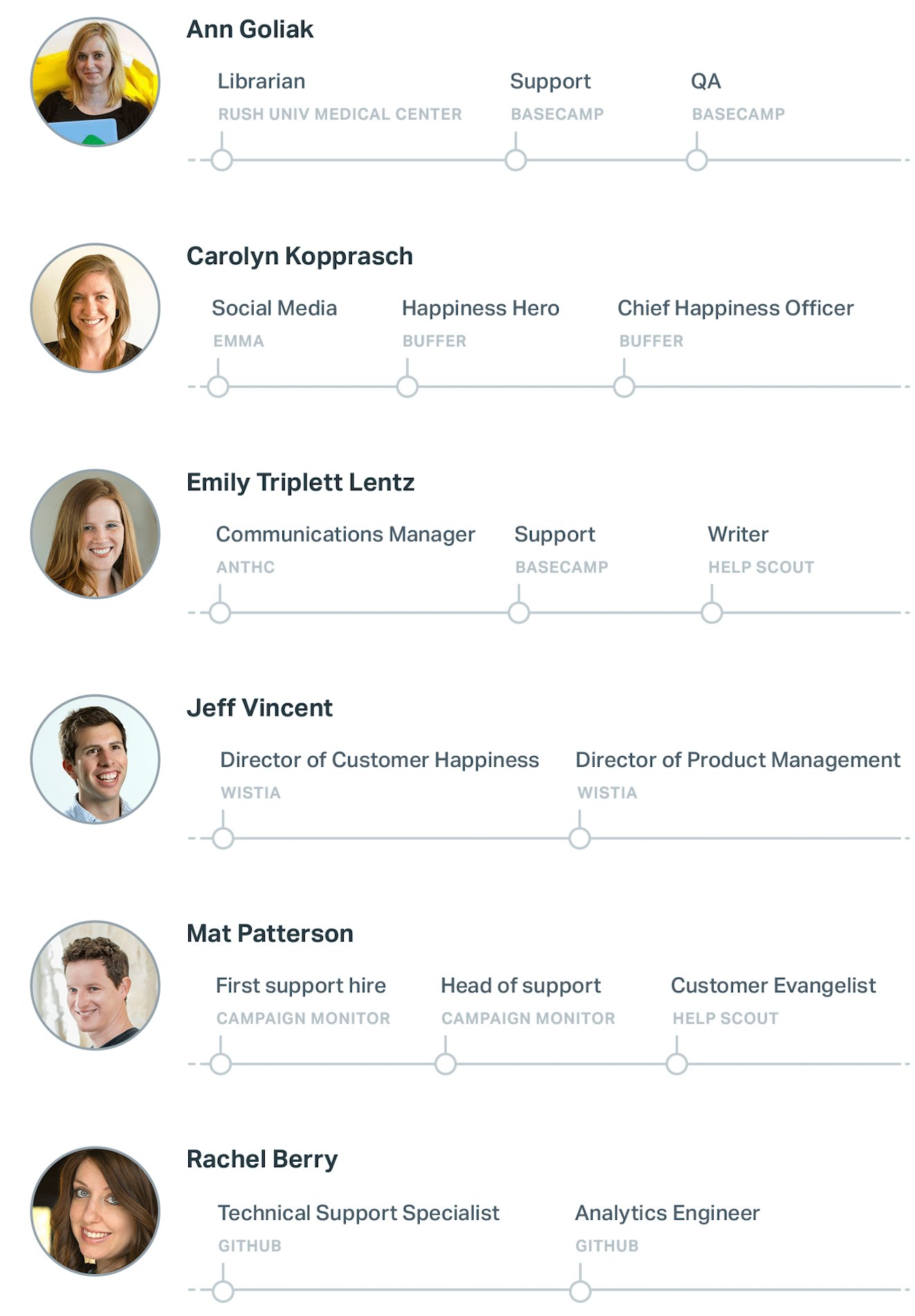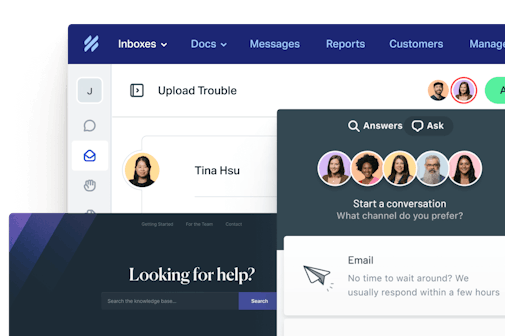The nature of customer service work tends to lend itself to a short-term, firefighting, just-cross-things-off-the list cadence. Close one conversation, and there's another one waiting for you. Focus, close. Focus, close.
It can be rapid-fire and relentless, and we might feel guilty taking time away from helping people (or like we’re not being a team player) by designating time to think about ourselves, our needs, and our careers.
But that way of working is a recipe for stagnation and burnout. Customer service reps are up there with teachers, first responders, and social workers in terms of occupational burnout due to all of the emotional labor we expend. Think about it: A huge predictor of burnout is putting others’ needs before your own.
But the opposite of burnout is engagement, and the best predictor of engagement is making progress on meaningful work.
So if you’re not thinking about what the next few years look like in your support position — about what you want your customer service career path to look like — you’re asking to burn out. That’s why it’s critical to set aside time to think about what growth and progress look like for you.
What does a career in customer service look like?
The good news is that customer service career options abound; working in support can lead to so many different career paths, it would be practically impossible to cover them all.
Here are six career paths that six different support professionals have followed:

Defining your customer service career path
Since customer support as we know it is both relatively new and rapidly evolving, you may still wonder what kinds of career paths are available to you.
The good news is that support career options abound. We’re not limited by a linear track. If you go to nursing school, you’ll probably wind up being a nurse; when you work in support, you get to write your own ticket based on what interests you.
The flip side of having all these options, of course, is the tyranny of choice. If you’re not really sure which direction you want to grow in, it can be hard to figure out your next step.
That’s why it’s good to set aside time on a regular basis — I’d recommend quarterly — to think about where you want to go and the steps you’ll need to take to get there. Put a recurring event on your calendar if that’s what it takes.
And here’s a super special magic trick that works like a charm: Write down what you want. Put it out there in the universe, as Oprah would say.
Think about where you want your career to go and write it down. That simple act helps transform wouldn’t-it-be-nice daydreaming into concrete goals you’re working toward, even subconsciously. And then tell your supervisor! Make your supervisor a partner in getting you where you want to go.
Do you want to lead people or specialize?
If you’re doing frontline support and you want to grow your career within or adjacent to this field, you have a couple general options: people leadership or domain leadership — that is, management or specialization as an individual contributor.
Pursuing a people leadership role
If people leadership — management — is what interests you, great! The good news is that we’re seeing customer-related positions open up at the C-Suite level — Allstate has a chief customer officer, FedEx has a chief customer officer, Boeing and Dunkin’ Brands both have one — signifying a corresponding growth of opportunities.
As customer service evolves and more companies buy into its value, more and more of these spots for team leads and managers open up as well, so the industry trend is in our favor.
You can talk to people who have done frontline support and then moved into leadership about how they did it. Ask them for their story. We’re so lucky that we work in a field where everyone is innately helpful. You won’t find a more supportive community anywhere.
Andrew Spittle, for example, heads up the Happiness team at Automattic, which is broken down into 21 individual teams ranging in size from 5-20 Happiness Engineers. Each has a Team Lead responsible for guiding the direction of the team and providing individual coaching and feedback.
“When someone indicates interest in a Team Lead role, we challenge them to lead projects and organize Happiness Engineers around hard problems to build their experience,” says Team Lead Jeremey DuVall. “From there, we provide coaching and feedback to help them improve and ideally build out a base of future leaders within the organization.”
If leadership positions appeal to you, tell your leaders! Make them partners in your career growth. That’s how Taylor Morgan became the support manager at SurveyGizmo:
“I started at SurveyGizmo as a Customer Support Hero, then moved into a Team Lead role, then took over management for the Support Team, and now I’m working towards a Directorship.
Everybody around me was moving to other roles, moving into development, QA, or sales, and I didn’t want to do any of those things.
So when my boss asked me what I wanted to do, I said, ‘well, I think I kind of like your job.’ She had other opportunities coming her way and needed some help at the time, so it worked out for both of us.”
Not every company will be as proactive about employees’ personal development — or as committed to hiring from within. And no matter how supportive your organization, it’ll still take a heavy amount of personal initiative to acquire the skills and knowledge you’ll need to move into leadership roles.
Pursuing a domain leadership role
“A lot of people feel like they have to move into management to have a support career,” says Help Scout’s Mat Patterson, “and in many companies that is probably true.” But if you find the right situation, you can take advantage of alternate options geared toward individual contributors rather than managers.
Here are some practical ways to grow your career in support as a domain leader instead of pursuing the management track or people leadership:
Think in terms of your resume
This advice comes from Help Scout alum Suneet Bhatt. He says that when he’s setting long-term goals for himself, he always tries to think in terms of things he hasn’t done before. Where are the gaps in your knowledge; where do you have more opportunity for growth?
Focus on that, and set aside some time in the future to look at how that’s going and what to set your sights on next. Thinking in terms of your resume just means asking how you can add a new notch in your belt.
Develop and hone a skill in a particular area
My background was in writing and editing when I took a support position at Basecamp. During my time there I continued to write — I worked on knowledge base documentation, and I wrote for the Signal v. Noise blog.
I didn't have a specific goal; I was just continuing to work on a skill that interested me. But when a writing position opened at Help Scout, it felt like the job description was written for me. That’s how I got to what I’m doing now.
Jim Mackenzie, also at Basecamp, studied API documentation and started handling conversations that required more technical research and problem-solving, and Basecamp essentially created a “tier two” support role for him.
Carissa Phillips, while working in support at Campaign Monitor, deepened her email deliverability skills and moved into a new role that way.
The common theme in all of these stories: Career growth came from taking the initiative to develop a skill they were interested in that also benefited the company.
Consider training and mentoring
Fast-growing companies often need to do a lot of support team hiring. Mailchimp, for example, has full-time training roles: People whose whole job it is to help new folks get up to speed, understand the culture, and start contributing quickly. That work doesn’t have to be done by a “manager.”
Build a profile
This might be most relevant to people who feel like they might need to make a move to a different company in order to grow: You know a ton of stuff, so share it with others on a blog or in a newsletter so you can generate new options for yourself.
A professional Twitter presence and contributions to the Support Driven community will help, too. A number of people in this community keep awesome personal blogs about support if you’re looking for inspiration as to building a personal brand.
Career paths for customer service agents at Help Scout
Help Scout is still a small company, and our Customers Team finds itself not just delivering great support for a constantly improving and expanding product, but also delivering elements of our sales, finance, business development, and marketing functions.
So when our Head of Customers Team Abigail Phillips is hiring new team members, she is looking for people with a diverse set of skills and a willingness to constantly learn.
Those folks are out there, but they are in high demand and always looking to grow. Keeping them engaged and satisfied in their roles means giving them plenty of opportunities to progress in their careers.
As in many small companies, there is no clearly defined “corporate ladder” for Help Scout’s Customers Team members to clamber up. Instead, Help Scout offers two broad paths for customer support career growth: Generalist and Specialist.
Generalists
Every new member of the Customers Team starts in a Generalist role as they learn about Help Scout’s products and approach to customer service. A Generalist’s work includes:
Offering frontline email and chat support for customers and prospective customers.
Handling phone calls, product demonstrations, and customer training as required.
Improving internal and external documentation and maintaining saved replies and workflows.
Collecting and reporting on customer experiences to the product teams.
Recording product issues and documenting feature requests.
Acting as a knowledge resource for the rest of the company, particularly during Whole Company Support times.
Generalists focus on deepening their product knowledge and sharpening their customer support skills.
For people who decide to stay on the Generalist path, career progress comes from developing a deep expertise in Help Scout’s products and finding ways to use that expertise to both deliver better service to customers and to educate and support their colleagues across the company.
Team members can rise up through the skill levels and salary bands while continuing to focus on frontline support work. As they progress, both Help Scout and our customers benefit from all of that valuable knowledge and experience.
Generalists may also end up in Coach roles, acting as trainers and resources for new colleagues. Sarah-Mei Estrada is currently a Coach on the Customers Team:
“I love being a coach! It means I get to work with smart, fun, empathetic people every day. One of my favorite things is to learn about my teammates: How are they currently feeling about their work? What are ways they'd like to grow themselves or impact the team? I really appreciate being able to support them as they continually progress.”
Specialists
Customers Team Specialists spend time out of the main queue, working on their particular speciality. It typically begins at 20% “out of queue” time and may rise as high as 80%.
Currently, there are three specialities available:
1. Growth Specialist
Mission: Improve product adoption and retention by serving as a partner and consultant to potential and current Help Scout customers.
Responsibilities outside the general queue include:
Strategic leadership for support-driven growth initiatives.
Maintaining a tight working relationship with our Marketing and Sales teams and assisting with new engagement experiments and marketing/blog efforts.
Conducting trial and pretrial consultations with qualified potential customers.
Connecting larger potential customers with our account executives.
Reaching out to customers at key moments in their experiences to help them get the most from their usage.
Developing ideas for how to educate our customers on the “why” of using a help desk instead of just the “how.”
Conducting weekly product tours and webinars in a one-to-many format.
2. Culture Specialist
Mission: Improve the health, happiness, and training of our team as we grow, and be an advocate for company culture.
Responsibilities include:
Helping to onboard new team members.
Organizing and evangelizing our Whole Company Support efforts.
Leading internal training initiatives.
Developing and running programs to build the team’s closeness and happiness.
Managing internal documentation and resources for team culture and onboarding.
Working closely with our People Ops team on culture-building activities.
Answering community questions (for example, in the Support Driven Slack group).
Supporting our customers on social media channels and being a public voice of the company.
I used to undervalue my natural ‘soft skills’, but now I see the huge business impact that community building has at Help Scout. Creating happier, more connected customers and staff really contributes to building better products and a more successful company. It’s a great opportunity for me to grow in my role and play to my strengths.
Kristi Thompson
3. Product Specialist
Mission: Be the voice of the customer for our Engineering, Product, and Design teams, and nurture product discussions within the Customers team.
Responsibilities include:
Actively building a closer working relationship with our Product teams.
Helping collate, prioritize, and elaborate on bugs and improvements so they are more easily actioned.
Taking the lead on managing unexpected outages and downtime.
Leading the creation of new customer-facing documentation.
Identifying ways to reduce incoming support through product improvements.
Tracking and reporting on themes and trends in customer questions.
Building internal technical documentation for the Customers Team.
Leading discussions on privacy and security issues impacting the Customers Team.
Being a Product Specialist is rewarding on so many levels. Not only do I get to spend my days working with customers and the support team, I also work with both product and engineering by providing customer insights on ongoing projects. It offers a direct line to help impact how the product changes and evolves while staying connected with our customers. For me, it’s the best of both worlds!
Elyse Roach
Following a Customers Team career path
Abigail begins the process of helping her new team members plan their career growth with Help Scout even before they are officially hired. During the interview process, candidates answer a few questions about what they are most personally interested in and where their experience and skills lie.
That helps give prospective team members a sense of the options available, but it also helps maintain a diverse and well-balanced team makeup in the long term. After joining, new members are heads-down learning the product, meeting customers through their support requests, and settling in to the company culture.
Once a team member has reached a high level of performance (and has a minimum of six months experience), they’ll start chatting with Abigail about their abilities, their interests, and what specializations the team currently needs most.
Key features of the Customers Team career model
Team members are never locked in. They can test the waters, try some sample projects, and move between specialities over time.
Specialities are not fixed. The Customers Team continues to evolve, and there is potential for new specialities to be added. If team members can identify an opportunity that interests them and show how it will be a multiplier for the rest of the team, they could potentially take it on.
Generalist roles are highly valued as the “general practitioners” of support. You can grow skills and your compensation without being a specialist.
Elevating customer service as a profession
Part of building a career in customer support is elevating the profession itself.
Many organizations still view their customer service department as a cost center, and it's hard not to internalize that negative perception.
Even when we get a great new customer support job, we don’t race to tell our families about it — we know what kinds of experiences they’ve had with Comcast. We know what people are picturing when we say we work in support, and it’s not pretty.
But that’s a counterproductive attitude, says Automattic’s Andrew Spittle, and we’re not going to change the public perception if we’re selling ourselves short:
“There’s a lot that support teams can do to influence and impact a company, but we too often get hung up on the idea that the only way to have influence is to move out of support. We have to be confident that the work we do adds value and, if others aren’t that confident, seek out the information that proves it to them.”
That doesn’t mean support professionals should have their figurative dukes up all the time, justifying the importance of their work, but it does beg the question: If support needs defending, is it really all that valuable?
“If all you do is defensive justification of your work, then it isn’t a ringing endorsement that you know what kind of impact you have,” Spittle says. “Don’t defend it; advocate for it.”
For those of us interested in changing the conversation around support and building successful careers within it, here are five ways we can do just that.
1. Take the initiative to demonstrate your value
Taking the initiative to demonstrate your value means embracing data and measurement, holding your team accountable to their goals, and communicating about your progress.
“Fronting as a self-proclaimed ‘people person’ and having a passion for problem solving aren’t enough to fuel the fire needed for long-term growth in a support role,” says Help Scout’s Justin Seymour. Support teams need to get comfy measuring their own work and linking those measurements to their organization’s larger goals.
“If we can do that, we can start adding value across the company,” says Spittle, and “actively combat the notion that support’s just a cost center.”
2. Take on projects that help you develop the skills that interest you
No one should spend 40 hours per week in the queue anyway — that’s a recipe for burnout. If you like to write, pitch in with knowledge base documentation or the company blog. If you’ve always wanted to learn to code, maybe start by writing some simple scripts that can help automate some support processes.
The best workplaces encourage team members to dedicate time to these useful side projects, which will often open up previously unforeseen opportunities.
3. Find your people
They’re out there. Community resources like Support Driven and SupportOps are elevating the profession and its practitioners, and they make it easy to get involved.
Follow support leaders on Twitter, chat with peers in Slack, attend conferences and local meetups; you’ll find the support community is about as supportive as they come.
Same goes for within your organization. Mireille Pilloud, Community Support Manager at TED, recommends finding your “cool aunt” at work — “an ally with whom you can share resources for mutual benefit.”
Seeking out and befriending these cross-team decision makers will help you gain a seat at the adult table since “they can help legitimize what you do to other teams so that they can also benefit from the work you do.”
4. Take pride in your work
When people ask what you do for work, take a little extra time to explain what your work entails. Not only will your friends and family gain a clearer sense of what you do, but little by little, you’ll be helping shift the public perception of what it means to work in customer support.
“It’s futile to hope that you can make a healthy career out of something you don’t feel pride about,” Spittle says. “If you’re shy about even telling family and friends that you work in support, then I’m not sure how that translates to a healthy and confident career.”
5. Work for a company that gets it
As more companies recognize the business case for offering true customer-first support, they’ll be competing more and more to hire the most skilled support professionals. This gives said professionals the ability to vote with their employability, so to speak.
The best support pros aren’t going to stay with organizations who undervalue their contribution.
“There are companies who view support as entry-level only, and there are companies who put customers first. If you’re in it for the long haul, work for a company who views the support team as one of their most important assets,” says Seymour.
“Support teams at great companies are well paid, and they’ve got a respected seat at the table during customer feedback and roadmap discussions. If you’re not 100% in love with the company and the product you’re supporting, pack your bags and find an organization you can get behind.”
By advocating for your own career in support, you’re advocating for everyone. You win, your community wins, your company wins. It’s time to stop defending support and start elevating the profession to see how high we can take it from here.
Make the most of your time in support
Just because support has evolved into a legitimate career field doesn’t mean anyone has to stay there forever — it’s okay to be honest that support experience can lead to other opportunities.
The important thing is to make the most of your time in support. That way, whatever comes next, you’ll have grown rather than stagnated.
If you’re not thinking about what three to five years looks like in a support position before you commit to the job, you’ll burn out.
Justin Seymour
With no expectations and no goals, nothing happens. “It’s fine if aspirations are elsewhere, whether that be a personal business or another line of work,” Seymour says. “As long as we have those expectations set, we can help get them to where they want to be.”
In advocating for your own career in support, by extension, you’re advocating for everyone. You win, your community wins, and your company wins.










